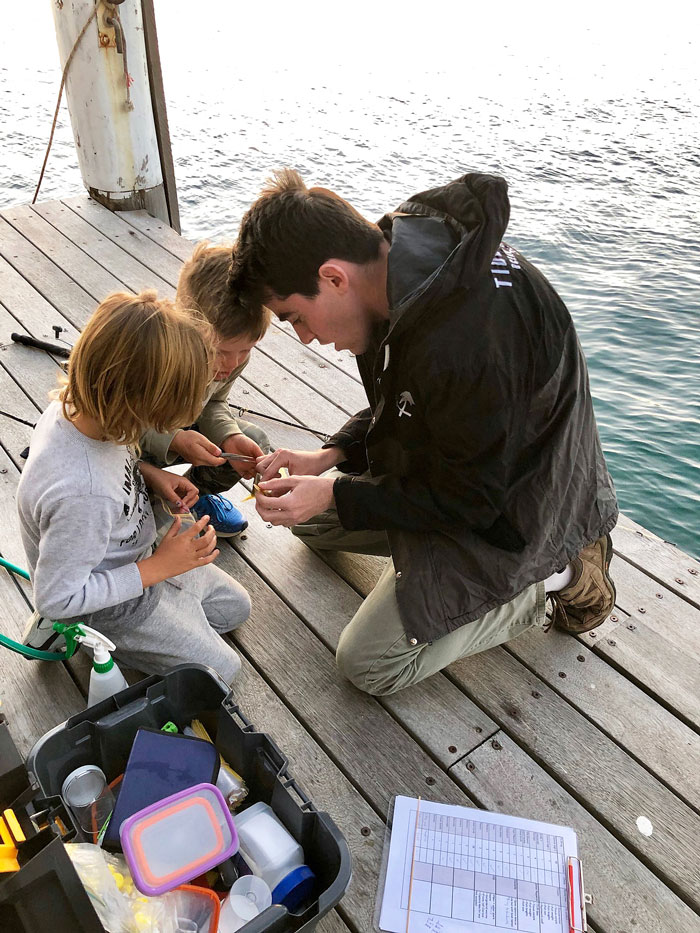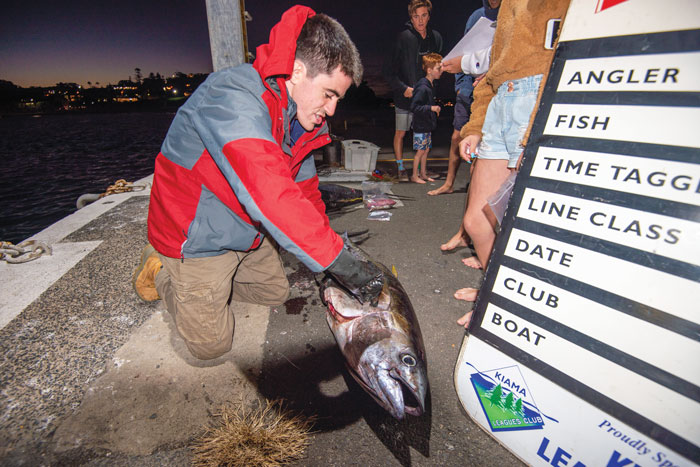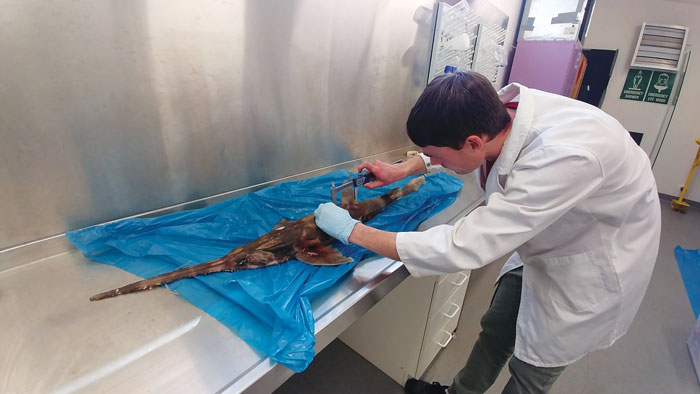Student research focused on improving commercial fishery and ecosystem interactions were highlights of the annual marine sciences conference
By Catherine Norwood

Three outstanding presentations from marine science students won FRDC-sponsored awards at the 2021 annual conference of the Australian Marine Sciences Association (AMSA).
Held as a virtual event for the first time this year, the conference ran from 28 June to 1 July, with the theme of ‘Marine Science in the Anthropocene’. Anthropocene is the term coined for the latest epoch in the history of Earth’s evolution, characterised by the impact of human activity on Earth’s climate and ecosystems.
The presentations winning this year’s FRDC awards addressed evolutionary population changes, ecological relationships and an impact on commercial fish quality.
Winners were Tristan Guillemin and Ryan Nevatte, both at Macquarie University, and Jessica Bolin from the University of the Sunshine Coast.
Sawshark populations
Ryan Nevatte’s PhD research focused on the population structure of two species of sawshark –Common Sawshark (Pristiophorus cirratus) and Southern Sawshark (Pristiophorus nudipinnis).
Both species are part of the incidental catch in commercial fisheries operating in southern Australia, but much of the biology of these species remains unknown.
Nevatte’s research has identified different evolutionary paths for these sawsharks that have led to different population structures. The Common Sawshark has two genetically distinct populations, roughly corresponding to an eastern and southern population. In contrast, the Southern Sawshark has a single population. DNA sequencing was applied to tissue samples of both species collected from several locations throughout their ranges. These data also helped to identify whether populations of either species had expanded in the past and to estimate how long ago this occurred based on the mutation rate of the genes.
In addition to the different population structures, the DNA markers suggested the Southern Sawshark had expanded its population. Evidence of expansion was also found in one of the two Common Sawshark populations.
Nevatte says the population expansions are estimated to have occurred about 50,000 to 150,000 years ago during the Pleistocene, a time when repeated glaciation events caused sea levels to rise and fall.
“In southern Australia, these changes in sea level caused Bass Strait to open and close, with the formation of a land bridge between Tasmania and mainland Australia,” explains Nevatte. “The signals of population expansion are likely due to this repeated opening and closing of the strait, with sawsharks recolonising the strait when it became flooded with seawater.
“The land bridge could also explain the presence of two lineages in the Common Sawshark, as this would have acted as a barrier to gene flow between sawsharks occurring to the east and west of Bass Strait.”
He suggests fisheries managers should consider adopting two management units for the Common Sawshark and use a single management unit for the Southern Sawshark. The signals of population expansion and stable population size also suggest these species are resilient to the current levels of fishing activity.
This research was recently published in the journal Reviews in Fish Biology and Fisheries.
What marlin eat
Tristan Guillemin’s Master of Research project investigated the diets of marlin species to better understand potential impacts of changes in the abundance of other species on this apex predator.
“Changes in food availability for these apex predators could have profound impacts on both our fisheries and the oceanic environment,” says Guillemin. “But the vastness of the open ocean makes it incredibly difficult to study feeding behaviours of important fishery species such as marlin. Without knowing which prey species these fish depend on, we can do little to protect and maintain healthy prey populations.”
He worked closely with the New South Wales Game Fishing Association (NSWGFA) and its many fishing clubs to identify the diets of two Australian marlin species, Blue Marlin (Makaira nigricans) and Striped Marlin (Kajikia audax).
Collecting tissue samples from marlin captured at game fishing tournaments, Guillemin analysed the stable isotopes in each sample.
“As fish feed on different prey species or in different environments, they retain the ‘isotope signature’ of what they fed on or where they fed. We can measure a fish’s isotope signature to make inferences about their feeding behaviour,” he explains.
“Using these methods, my supervisors and I were the first to show that Blue and Striped Marlin have different feeding behaviours on the temperate east coast of Australia.”
He says Blue Marlin appear to be picky eaters when it came to the species they fed on, but not too concerned about the size of their prey, likely feeding on tunas ranging from small Skipjack Tuna (Katsuwonus pelamis) to big Yellowfin Tuna (Thunnus albacares).

Photo: Supplied


Conversely, Striped Marlin fed on a wider range of prey species, but all of a similar size, such as smaller schooling species.
“Dietary differences suggest that these species might have different susceptibilities to changes in prey abundance, and that we need to manage them accordingly,” he says.
Swordfish quality
Jessica Bolin’s PhD research, meanwhile, is focused on the notoriously difficult to predict phenomenon of myoliquefaction – or ‘jellymeat’ – which affects Swordfish (Xiphias gladius) harvested in Australia’s Eastern Tuna and Billfish Fishery (ETBF). Jellymeat is caused by parasitic infection by Kudoa musculoliquefaciens, which turns Swordfish meat into a soft and mushy texture. However, the condition only occurs post-mortem, making it difficult for fishers to identify affected fish as they catch them.
The parasite found in eastern Australian waters is not known to pose a risk to human health, but jellymeat reduces the value of the product, posing a risk to both the profitability and ecological sustainability of the industry.
Bolin says some ETBF fishers report experiencing jellymeat more often in summer, or when waters fished are warmer than usual. Her industry partners in this project are Walker Seafoods Australia and 4 Seas Pty Ltd, both based at Mooloolaba, Queensland.
Her aim is to clearly identify the relationships between the prevalence and intensity of Kudoa infection rates and ocean conditions. To do this, Bolin is using data science, combining ecological modelling, temperature and ocean current data, and information about the prevalence and intensity of Kudoa sp. infection in harvested Swordfish.
If a relationship is clearly identified, she then plans to use ecological modelling techniques to generate ‘nowcasts’ of where and when infected Swordfish are more likely to occur throughout the fishery, based on contemporary ocean conditions, and to collaborate with the Bureau of Meteorology to produce seasonal forecasts to help fishers better plan their trips.
Bolin says the ultimate aim of the project is to provide fishers with a proactive way to maintain the quality of their harvest by reducing the risk of catching infected Swordfish, reducing wasted effort and wasted catch in this important quota-managed fishery. f
R&D Plan Outcome 1
Growth for enduring prosperity
More information
Australian Marine Sciences Association, https://www.amsa.asn.au





